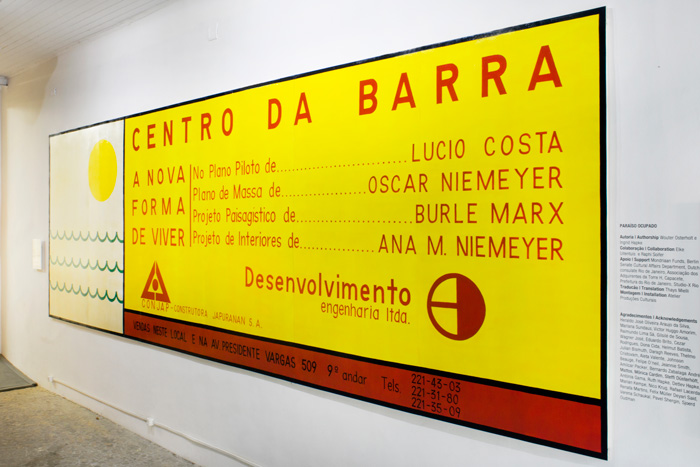Artist:
Wouter Osterholt (born 1979 in Leiden, the Netherlands; lives and works in Berlin, Germany).
Elke Uitentuis (born 1977 in the Netherlands; lives and works in Berlin, Germany).
Materials:
Mixed media installation.
Description:
“[Paraíso Ocupado] (Portuguese for ‘Occupied Paradise’) is a reconstruction of a failed modernist plan for an urban center located in the West zone of Rio de Janeiro. This plan, designed by Oscar Niemeyer, was officially approved in 1970 and served as inspiration for Lúcio Costa’s Pilot Plan for the greater region. All the documents in the exhibition are part of an abandoned archive found in the ruin of one of the three actually constructed circular towers. A website with the digitalized documents was launched with the exhibition, so the material became accessible to the public. This precedes the ultimate objective of Paraíso Ocupado: the establishment of a museum concerned with the urbanization history of Barra da Tijuca.”
—”Paraíso Ocupado,” Wouter Osterholt website.
“This exhibition is a long-term research project, which aims to revisit and reconstruct the master plan Centro da Barra, later known as Athaydeville, an urban center located in Barra da Tijuca, in the Westzone of Rio de Janeiro. This plan, designed by Oscar Niemeyer, was officially approved in 1970 (he had worked on it for three years) and served as inspiration for Lúcio Costa’s Pilot Plan for the greater neighborhood in the lowlands of Jacarepaguá (1969).
“The models and unpublished documentation material exhibited here bring to light the singularities of Barrada Tijuca’s urbanization. The documents are part of an abandoned archive found in the ruins of one of the three towers, that were actually built. Parallely, a website (www.paraisoocupado.com) with the digitalized documents is being launched in order to raise awareness and to make this material accessible to the public. With this exhibition, Wouter Osterholt and Ingrid Hapke, take a first step towards the establishment of a future museum dedicated to the history of Barra da Tijuca’s urbanization.”
—”PARAÍSO OCUPADO,” Columbia GSAPP website.



